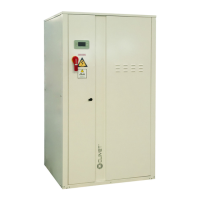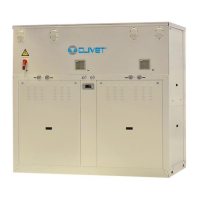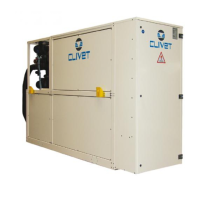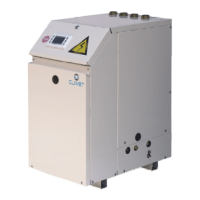Do you have a question about the CLIVET WSH-XEE2 35.2 and is the answer not in the manual?
Covers potential risks during operation, installation, and maintenance. Emphasizes qualified personnel.
Recommends periodic inspection and maintenance to reduce costs. Turn unit off before operation.
Instructs to disable unit immediately and contact authorized service agent for breakdown/malfunction.
Provides step-by-step instructions for safely handling and lifting the unit.
Guides on where and how to install units, considering fixed positions and vibration.
Details water features, quality requirements, and potential issues with inadequate water.
Details the process of making hydraulic connections, including welding unions.
Explains the necessity of a flow switch for unit shutdown if water is not circulating.
Details the step-by-step sequence for filling and operating the unit's hydraulic circuit.
Provides steps for making electrical connections, including isolation and earth connection.
Details how to connect a PC for configuration and troubleshooting, including network settings.
Outlines startup procedures, emphasizing qualified technicians and manual adherence.
Lists essential checks before unit power supply, including safety and functional spaces.
Details the step-by-step process for starting up the unit after preliminary checks.
Provides checks for the refrigeration circuit, including oil stains, pressure, and valve status.
Guides on checking the water circuit, ensuring it's clean, filled, pressurized, and free of air.
Covers checks for grounding, conductor tightness, voltage, frequency, and phase balance.
Explains how to limit absorbed electric power using an external signal (0-10 Vcc).
Details the ECOSHARE function for automatic management of multiple units connected in a network.
Explains how to check evaporator water flow-rate and pressure drops.
Warns about damages from prolonged operation at reduced load and frequent stops.
Provides steps to change the unit's local state (OFF, ECO, ON, Pump On).
Details how to modify setpoints for cooling, heating, and hot water.
Explains how to identify, display, and reset alarms, emphasizing cause removal.
Provides a comprehensive list of alarm codes, their descriptions, and associated faults.
Outlines maintenance goals, requirements, and safety precautions before inspections.
Recommends inspection frequency (every 6 months) and lists specific checks.
Covers potential risks during operation, installation, and maintenance. Emphasizes qualified personnel.
Recommends periodic inspection and maintenance to reduce costs. Turn unit off before operation.
Instructs to disable unit immediately and contact authorized service agent for breakdown/malfunction.
Provides step-by-step instructions for safely handling and lifting the unit.
Guides on where and how to install units, considering fixed positions and vibration.
Details water features, quality requirements, and potential issues with inadequate water.
Details the process of making hydraulic connections, including welding unions.
Explains the necessity of a flow switch for unit shutdown if water is not circulating.
Details the step-by-step sequence for filling and operating the unit's hydraulic circuit.
Provides steps for making electrical connections, including isolation and earth connection.
Details how to connect a PC for configuration and troubleshooting, including network settings.
Outlines startup procedures, emphasizing qualified technicians and manual adherence.
Lists essential checks before unit power supply, including safety and functional spaces.
Details the step-by-step process for starting up the unit after preliminary checks.
Provides checks for the refrigeration circuit, including oil stains, pressure, and valve status.
Guides on checking the water circuit, ensuring it's clean, filled, pressurized, and free of air.
Covers checks for grounding, conductor tightness, voltage, frequency, and phase balance.
Explains how to limit absorbed electric power using an external signal (0-10 Vcc).
Details the ECOSHARE function for automatic management of multiple units connected in a network.
Explains how to check evaporator water flow-rate and pressure drops.
Warns about damages from prolonged operation at reduced load and frequent stops.
Provides steps to change the unit's local state (OFF, ECO, ON, Pump On).
Details how to modify setpoints for cooling, heating, and hot water.
Explains how to identify, display, and reset alarms, emphasizing cause removal.
Provides a comprehensive list of alarm codes, their descriptions, and associated faults.
Outlines maintenance goals, requirements, and safety precautions before inspections.
Recommends inspection frequency (every 6 months) and lists specific checks.











